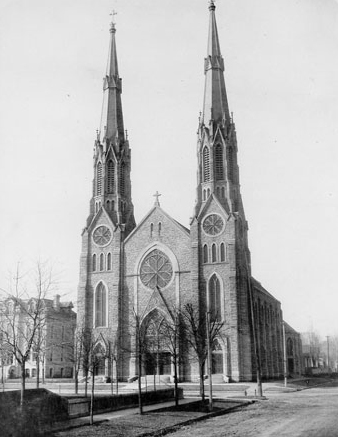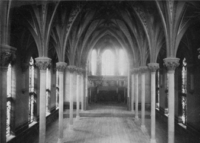By Norman V. Kelly
 Sunday, June 28, 1885 dawned bright with promise here in Peoria, Illinois. This day was to be a very special day for the Catholics living not only in Peoria County but many surrounding counties as well. Although it was indeed a Catholic day, the entire city and county of Peoria would participate. Some of them would just come for the exciting marching bands and the pageantry of the parade, but to many it was a religiously important day as well.
Sunday, June 28, 1885 dawned bright with promise here in Peoria, Illinois. This day was to be a very special day for the Catholics living not only in Peoria County but many surrounding counties as well. Although it was indeed a Catholic day, the entire city and county of Peoria would participate. Some of them would just come for the exciting marching bands and the pageantry of the parade, but to many it was a religiously important day as well.
The excitement centered around the magnificent, breath taking beauty of the new Saint Mary’s Cathedral that was to be erected on Madison and Green Streets in downtown Peoria, Illinois. What Peorian, returning home has not felt the swell of excitement crossing the bridge to downtown Peoria? The sight of Peoria after a long auto trip is exciting enough, but over to the right, its two giant twin spires bathed in light, is the magnificent Saint Mary’s Cathedral. That landmark has been there throughout the years welcoming folks home.
Today would be the setting of the cornerstone for this great church and thousands would be here in town to witness the pomp and ceremony. Casper Mehler was authorized to begin the drawings of the plans for the church on April 22, 1894. Once they were completed the contractor, Mathias Schnell took over and the first stone was laid on May 15, 1884. Mr. Schnell was from Rock Island, Illinois, but most of the workers from the church were from this area.
 June 28, 1895 was picked as the day when the cornerstone would be installed, even though considerable construction had already been completed. Folks, congregations, organizations, church leaders, and organized societies were invited to attend. People began coming into the city by every means of transportation available in 1885. The local folks made up welcoming committees and met the visitors at the train depot, escorting them to their own homes, hotels, inns and churches throughout the city.
June 28, 1895 was picked as the day when the cornerstone would be installed, even though considerable construction had already been completed. Folks, congregations, organizations, church leaders, and organized societies were invited to attend. People began coming into the city by every means of transportation available in 1885. The local folks made up welcoming committees and met the visitors at the train depot, escorting them to their own homes, hotels, inns and churches throughout the city.
Early on June 28, 1885, people from all over the state came together downtown to form the gigantic parade that would form up around the courthouse. Three of the largest and best bands in the state would lead the parade, followed by smaller bands and marching societies. Some of them were very large, including Knights of St. George, the Irish Hibernians, temperance groups and dozens of brightly dressed, exuberant groups. Spencer’s band, a very famous band, entertained as the groups formed and would also march in the parade.
By two that afternoon, clouds rolled in and a light drizzle brought out colorful umbrellas, but the clouds soon passed. The Grand Marshal, Honorable Edward Spellman, signaled all was ready and the front band struck up a joyous piece and off they stepped up Adams, then up Main and over to Madison where they crowded up and around Green Street to the Cathedral. Thousands lined the parade route and then fell in behind the marchers as they all headed for the ceremonies. This certainly was an event open to the entire town and many felt pride along with the Catholics. Bishop John Lancaster Spalding made his way to the platform erected near the cornerstone and looked out at the huge, smiling crowd. He held up his hands and then welcomed everyone. The bishop then made his way to the altar with several priest to bless the cross. The bishop wore purple with a white rochet, while the priests wore white. It was a solemn occasion, but the happiness was evident in the faces of the crowd and the participants.
The contingent then made its way to the large cornerstone where the blessing of the foundation and the stone took place. A litany to the saints was spoken as the ceremonies ended. The bishop then spoke to the people gathered there at the great church.
The bishop spoke for several minutes about how the church had come about and invited everyone to keep the church alive and open to everyone. “This church shall be the center of light and power and unity for this whole diocese.” He then spoke elegantly about the City of Peoria, Illinois. “No man loves this city more than I do or is prouder of its present position, or hopeful for its future. There is no fairer site for a city in this country.” He then called upon pastors and people of other denominations to help support the building.
Bishop Spalding went on to tell the assemblage that he was certain that Peoria area’s population would be as many as 100,000 in the near future and that “This church will be built solidly, symbolizing the power and enduring life of the religion given to man by Jesus Christ.”
Click on the boxes below to read more details.
Editor’s Note: Norm welcomes your comments and you can also e-mail him: norman.kelly@sbcglobal.net





